Days Payable Outstanding (DPO) is an important financial metric that indicates how well a company handles its accounts payable. DPO is determined by dividing the average accounts payable amount by the cost of goods sold (COGS) and multiplying by the period’s number of days, which is commonly 365. This computation gives information about how long it takes a company to pay its suppliers, which represents cash flow management and overall financial health. According to a recent article from Allianz Trade, DPO measures the average time a company takes to pay its suppliers after purchasing goods or services.
In Singapore, where businesses are competitive and focused on efficiency, managing DPO is essential for maintaining cash flow and supplier relationships. This article will explore the importance of calculating DPO, how to measure it, and what constitutes a good DPO. We will also examine the factors influencing DPO, such as accounts payable, cost of goods sold (COGS), and the calculation period. Additionally, we will discuss how automation through modern software solutions can help businesses track and manage DPO, improving financial operations and decision-making.
- Days Payable Outstanding (DPO) is a financial metric that measures the average number of days a company takes to pay its suppliers after receiving goods or services.
- To calculate DPO, the formula is: DPO = (Accounts Payable / Cost of Goods Sold) × Number of Days, which helps businesses assess their payment cycle.
- Several factors impact DPO, including accounts payable, the number of days used for calculation, and the cost of goods sold.
- ScaleOcean’s HRIS software automates the calculation of DPO, streamlining financial processes and improving cash flow management for businesses.

1. What is the Days Payable Outstanding Formula (DPO)?
Days Payable Outstanding (DPO) is an important financial statistic that allows organizations to assess their success in handling accounts payable. It determines the average number of days it takes a corporation to pay its suppliers after receiving products or services. This indicator is crucial because it reveals how effectively a company manages its short-term liabilities. A high DPO means a company delays payments to suppliers, which helps cash flow but may harm supplier relationships. Managing this balance is like organizing key business documents, such as a payslip template, to handle both financial obligations and employee details efficiently.
In contrast, a low DPO indicates that payments are being paid rapidly, which could suggest high cash flow but may limit the company’s capacity to retain liquidity. Businesses that closely monitor and calculate DPO can detect cash management patterns, analyze payment strategies, and improve working capital. This makes DPO an important tool for financial planning and ensuring that the company strikes the appropriate balance between satisfying its financial obligations and managing its cash reserves.
Also Read: Best 15 HR Software in Singapore 2025
2. How to Calculate Days Payable Outstanding (DPO)
Days Payable Outstanding (DPO) is an important financial indicator that allows firms to track how long it takes on average to pay their suppliers. This statistic depicts how effectively a company manages its accounts payable, providing insights into cash flow management and financial strategy.
Understanding how to calculate DPO is crucial for businesses aiming to maximize working capital and maintain strong supplier relationships. The DPO calculation provides a straightforward method to assess the payment cycle and its impact on financial performance. The formula to calculate Days Payable Outstanding (DPO) is as follows:
DPO = (Accounts Payable/Cost of Goods Sold) × Number of Days
This formula includes three key components: accounts payable, cost of goods sold (COGS), and the number of days (usually 365). “Accounts payable” refers to the total amount owed to suppliers for products or services not yet paid for. “Cost of Goods Sold (COGS)” refers to the direct costs of producing the goods or services sold during a specific period.
The “Number of Days” field is usually set to 365, providing an annual measurement of supplier payment time. To calculate DPO, divide total accounts payable by cost of goods sold and multiply by 365. This shows the average number of days it takes the company to pay invoices, reflecting cash flow and financial efficiency.
3. What is a Good Day Payable Outstanding?

A decent Days Payable Outstanding (DPO) relies on the industry and the company’s cash flow requirements. A smaller DPO indicates that the company is paying off creditors rapidly, implying robust cash flow and financial soundness. However, this could also imply that the organization is not fully utilizing the credit terms offered by suppliers. A greater DPO allows a company to hold funds longer, aiding liquidity and business needs. However, delayed payments beyond agreed terms may harm supplier relationships. According to Kolleno, the average DPO varies by industry: retail is 30-45 days, manufacturing 50-70 days, technology 60-90 days, and healthcare 40-60 days.
To decide whether a DPO is good, organizations frequently compare it to the industry average. For example, a DPO of 20 indicates that the company pays its suppliers on average every 20 days. If this is much higher or lower than the industry norm, it could indicate that the company is either taking longer or paying more quickly than competitors. Finding the correct balance between improving cash flow and keeping healthy supplier relationships is critical to running a successful DPO.
4. Factors Related to Days Payable Outstanding
Several elements are strongly related to Days Payable Outstanding (DPO), which businesses must examine for good financial management. These factors influence the overall calculation of DPO and can assist organizations in maximizing cash flow while maintaining solid supplier relationships. This includes:
a. Accounts Payable
This is the total amount a corporation owes its suppliers for goods and services received. Managing accounts payable efficiently is critical for keeping DPO under control. Proper management of accounts payable can reduce a company’s DPO. This ensures timely payments and maintains strong financial health.
b. Number of Days
The DPO formula uses this period, which is commonly set to 365 days. It refers to the timeframe in which a corporation assesses its accounts payable. Using 365 days as a standard allows firms to measure DPO on a yearly basis, giving them a clear picture of how long it takes on average to pay off debts over the course of a year.
c. Cost of Goods Sold (COGS)
This indicates the direct costs of producing goods sold by the company. A higher COGS can result in a higher DPO since businesses may take longer to pay bills when costs are high. This may be a strategic decision to conserve cash flow for other operating expenses or investments. However, it is critical to ensure that payment delays do not have a detrimental impact on supplier relationships or the company’s reputation.
5. Calculate Days Payable Outstanding Automatically with ScaleOcean HRIS Software

ScaleOcean’s HRIS software is a comprehensive solution designed to automate and optimize financial processes, including the calculation of Days Payable Outstanding (DPO). This solution helps businesses manage accounts payable effectively, ensuring accurate payments and healthy cash flow. ScaleOcean automates DPO tracking, providing up-to-date financial data for better decision-making and improved financial management. ScaleOcean’s seamless integration and customisable capabilities simplify the DPO calculation process and improve cash flow efficiency.
ScaleOcean provides a free demo to organizations interested in learning more about the software’s ability to streamline financial operations. The software also qualifies for CTC grant, making it an affordable option for businesses looking to boost productivity without increasing their budget. The following are the unique selling characteristics (USP) of ScaleOcean’s software.
- All-in-One HRIS Solution – Complete Modules for Financial Management and Beyond, ScaleOcean’s HRIS software offers a comprehensive suite of over 200 modules designed to meet specific business needs, including modules for accounts payable and DPO management.
- Built from Best HR & Business Practices, ScaleOcean’s HRIS software is developed with industry-leading practices, addressing challenges in financial management, operational efficiency, and automation.
- Customizable HRIS Solution for Your Company’s Unique Needs, ScaleOcean allows businesses to tailor the HRIS system to fit their specific workflows, providing advanced customization options like personalized dashboards and smart configurations.
- Auto-Pilot HRIS for Streamlined Business Operations, ScaleOcean’s HRIS software is designed to automate various aspects of business operations, including DPO management
Also Read: List of Business Grants for Singapore Local Companies
6. Conclusion
Days Payable Outstanding (DPO) is a key financial metric that helps firms manage accounts payable and cash flow. By understanding its drivers and using solutions like ScaleOcean’s HRIS software, companies can optimize DPO. This leads to better financial management and stronger supplier relationships. Accurate DPO calculations enable businesses to make informed cash flow decisions and improve operational efficiency.
ScaleOcean provides a free demo to assist organizations in streamlining DPO calculations and optimizing their financial procedures. This demo allows you to see how the software’s automated capabilities may simplify accounts payable and improve cash flow management. Companies can use ScaleOcean’s solution to manage DPO effectively and benefit from a range of capabilities tailored to their needs.
FAQ:
1. How do you calculate days payable outstanding?
To calculate Days Payable Outstanding (DPO), divide the average accounts payable by the cost of goods sold (COGS), then multiply the result by the number of days in the period, typically 365. This gives you the average time it takes for a company to settle payments with its suppliers.
2. How do you calculate DPO and DSO?
DPO (Days Payable Outstanding) is calculated by dividing the average accounts payable by the cost of goods sold (COGS) and multiplying by 365. DSO (Days Sales Outstanding) is calculated by dividing accounts receivable by total sales and multiplying by 365.
3. What is the formula for AP days?
The formula for Accounts Payable (AP) days is calculated by dividing the average accounts payable by the cost of goods sold (COGS) and multiplying by 365. This gives the average number of days it takes a company to pay its creditors.
4. What is the formula for outstanding days?
The formula for calculating outstanding days is similar to DPO. It involves dividing accounts payable by the cost of goods sold (COGS) and multiplying by 365. This provides the average number of days a company takes to pay its outstanding debts.







 PTE LTD..png)
.png)

.png)








.png)
.png)
















